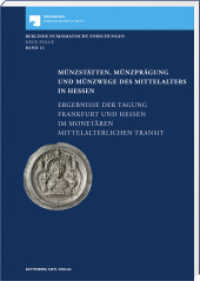- ホーム
- > 洋書
- > 英文書
- > Science / Mathematics
Full Description
The subject of computational plasticity encapsulates the numerical methods used for the finite element simulation of the behaviour of a wide range of engineering materials considered to be plastic - i.e. those that undergo a permanent change of shape in response to an applied force. Computational Methods for Plasticity: Theory and Applications describes the theory of the associated numerical methods for the simulation of a wide range of plastic engineering materials; from the simplest infinitesimal plasticity theory to more complex damage mechanics and finite strain crystal plasticity models. It is split into three parts - basic concepts, small strains and large strains. Beginning with elementary theory and progressing to advanced, complex theory and computer implementation, it is suitable for use at both introductory and advanced levels. The book:
Offers a self-contained text that allows the reader to learn computational plasticity theory and its implementation from one volume.
Includes many numerical examples that illustrate the application of the methodologies described.
Provides introductory material on related disciplines and procedures such as tensor analysis, continuum mechanics and finite elements for non-linear solid mechanics.
Is accompanied by purpose-developed finite element software that illustrates many of the techniques discussed in the text, downloadable from the book's companion website.
This comprehensive text will appeal to postgraduate and graduate students of civil, mechanical, aerospace and materials engineering as well as applied mathematics and courses with computational mechanics components. It will also be of interest to research engineers, scientists and software developers working in the field of computational solid mechanics.
Contents
Part One Basic concepts
1 Introduction
1.1 Aims and scope
1.2 Layout
1.3 General scheme of notation
2 ELEMENTS OF TENSOR ANALYSIS
2.1 Vectors
2.2 Second-order tensors
2.3 Higher-order tensors
2.4 Isotropic tensors
2.5 Differentiation
2.6 Linearisation of nonlinear problems
3 THERMODYNAMICS
3.1 Kinematics of deformation
3.2 Infinitesimal deformations
3.3 Forces. Stress Measures
3.4 Fundamental laws of thermodynamics
3.5 Constitutive theory
3.6 Weak equilibrium. The principle of virtual work
3.7 The quasi-static initial boundary value problem
4 The finite element method in quasi-static nonlinear solid mechanics
4.1 Displacement-based finite elements
4.2 Path-dependent materials. The incremental finite element procedure
4.3 Large strain formulation
4.4 Unstable equilibrium. The arc-length method
5 Overview of the program structure
5.1 Introduction
5.2 The main program
5.3 Data input and initialisation
5.4 The load incrementation loop. Overview
5.5 Material and element modularity
5.6 Elements. Implementation and management
5.7 Material models: implementation and management
Part Two Small strains
6 The mathematical theory of plasticity
6.1 Phenomenological aspects
6.2 One-dimensional constitutive model
6.3 General elastoplastic constitutive model
6.4 Classical yield criteria
6.5 Plastic flow rules
6.6 Hardening laws
7 Finite elements in small-strain plasticity problems
7.1 Preliminary implementation aspects
7.2 General numerical integration algorithm for elastoplastic constitutive equations
7.3 Application: integration algorithm for the isotropically hardening von Mises model
7.4 The consistent tangent modulus
7.5 Numerical examples with the von Mises model
7.6 Further application: the von Mises model with nonlinear mixed hardening
8 Computations with other basic plasticity models
8.1 The Tresca model
8.2 The Mohr-Coulomb model
8.3 The Drucker-Prager model
8.4 Examples
9 Plane stress plasticity
9.1 The basic plane stress plasticity problem
9.2 Plane stress constraint at the Gauss point level
9.3 Plane stress constraint at the structural level
9.4 Plane stress-projected plasticity models
9.5 Numerical examples
9.6 Other stress-constrained states
10 Advanced plasticity models
10.1 A modified Cam-Clay model for soils
10.2 A capped Drucker-Prager model for geomaterials
10.3 Anisotropic plasticity: the Hill, Hoffman and Barlat-Lian models
11 Viscoplasticity
11.1 Viscoplasticity: phenomenological aspects
11.2 One-dimensional viscoplasticity model
11.3 A von Mises-based multidimensional model
11.4 General viscoplastic constitutive model
11.5 General numerical framework
11.6 Application: computational implementation of a von Mises-based model
11.7 Examples
12 Damage mechanics
12.1 Physical aspects of internal damage in solids
12.2 Continuum damage mechanics
12.3 Lemaitre's elastoplastic damage theory
12.4 A simplified version of Lemaitre's model
12.5 Gurson's void growth model
12.6 Further issues in damage modelling
Part Three Large strains
13 Finite strain hyperelasticity
13.1 Hyperelasticity: basic concepts
13.2 Some particular models
13.3 Isotropic finite hyperelasticity in plane stress
13.4 Tangent moduli: the elasticity tensors
13.5 Application: Ogden material implementation
13.6 Numerical examples
13.7 Hyperelasticity with damage: the Mullins effect
14 Finite strain elastoplasticity
14.1 Finite strain elastoplasticity: a brief review
14.2 One-dimensional finite plasticity model
14.3 General hyperelastic-based multiplicative plasticity model
14.4 The general elastic predictor/return-mapping algorithm
14.5 The consistent spatial tangent modulus
14.6 Principal stress space-based implementation
14.7 Finite plasticity in plane stress
14.8 Finite viscoplasticity
14.9 Examples
14.10 Rate forms: hypoelastic-based plasticity models
14.11 Finite plasticity with kinematic hardening
15 Finite elements for large-strain incompressibility
15.1 The F-bar methodology
15.2 Enhanced assumed strain methods
15.3 Mixed u/p formulations
16 Anisotropic finite plasticity: Single crystals
16.1 Physical aspects
16.2 Plastic slip and the Schmid resolved shear stress
16.3 Single crystal simulation: a brief review
16.4 A general continuum model of single crystals
16.5 A general integration algorithm
16.6 An algorithm for a planar double-slip model
16.7 The consistent spatial tangent modulus
16.8 Numerical examples
16.9 Viscoplastic single crystals
Appendices
A Isotropic functions of a symmetric tensor
A.1 Isotropic scalar-valued functions
A.1.1 Representation
A.1.2 The derivative of anisotropic scalar function
A.2 Isotropic tensor-valued functions
A.2.1 Representation
A.2.2 The derivative of anisotropic tensor function
A.3 The two-dimensional case
A.3.1 Tensor function derivative
A.3.2 Plane strain and axisymmetric problems
A.4 The three-dimensional case
A.4.1 Function computation
A.4.2 Computation of the function derivative
A.5 A particular class of isotropic tensor functions
A.5.1 Two dimensions
A.5.2 Three dimensions
A.6 Alternative procedures
B The tensor exponential
B.1 The tensor exponential function
B.1.1 Some properties of the tensor exponential function
B.1.2 Computation of the tensor exponential function
B.2 The tensor exponential derivative
B.2.1 Computer implementation
B.3 Exponential map integrators
B.3.1 The generalised exponential map midpoint rule
C Linearisation of the virtual work
C.1 Infinitesimal deformations
C.2 Finite strains and deformations
C.2.1 Material description
C.2.2 Spatial description
D Array notation for computations with tensors
D.1 Second-order tensors
D.2 Fourth-order tensors
D.2.1 Operations with non-symmetric tensors
References
Index








